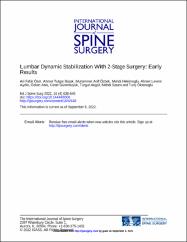Lumbar dynamic stabilization with 2-stage surgery: early results

Göster/
Erişim
info:eu-repo/semantics/openAccessTarih
2022Yazar
Özer, Ali FahirBaşak, Ahmet Tulgar
Özbek, Muhammet Arif
HekimoǧLu, Mehdi
Aydın, Ahmet Levent
Ateş, Özkan
Günerbüyük, Caner
Akgül, Turgut
Sasani, Mehdi
Öktenoǧlu, Tunç
Üst veri
Tüm öğe kaydını gösterKünye
Özer, A. F., Başak, A. T., Özbek, M. A., HekimoǧLu, M., Aydın, A. L., Ateş, Ö. ... Öktenoǧlu, T. (2022). Lumbar dynamic stabilization with 2-stage surgery: early results. International Journal of Spine Surgery, 16(4), 638-645. http://doi.org/10.14444/8306Özet
Background: Screw loosening, which is a major problem in dynamic systems, can be easily overcome with 2-stage surgery. In this article, the clinical and radiological results of patients undergoing dynamic stabilization with a Dynesys device in 2 stages are discussed. Methods: A total of 10 male and 13 female adult patients were included in this single-center retrospective study conducted between 2018 and 2021. The mean age of the patients was 65.6 years. All of the patients had pain complaints that affected their daily lives. Bone density T scores were determined with the dual-energy x-ray absorptiometry method before patients were admitted for surgery. In the first surgery, Dynesys system pedicle screws were inserted. After 6 months of osteointegration, Dynesys system spacers and elastic bandages were placed. Preoperative, early postoperative, and late postoperative visual analog pain scale (VAS) scores and Oswestry Disability Index (ODI) scores were determined and statistically compared. Results: Patients were followed for an average of 30 months. Complications and recurrence were not observed. Neurological deficits were not observed after patients recovered from anesthesia. Significant improvement was observed in the ODI and VAS parameters in the preoperative (ODI: 66.2%, VAS: 7.8), early postoperative (ODI: 20.3%, VAS: 2.4), and late postoperative (ODI: 6.8% and VAS: 1.1) periods. Symptomatic improvement was seen in all patients. No screw breakage or loosening was detected by radiological evaluation in any of the patients during the 2-year follow-up period. Conclusions: In our experience, the insufficiency of the proximal and distal end screws is eliminated when 2 stages of dynamic system stabilizations are completed after osteointegration of the screws.
Scopus Q Kategorisi
Q2Kaynak
International Journal of Spine SurgeryCilt
16Sayı
4Koleksiyonlar
- Makale Koleksiyonu [3770]
- PubMed İndeksli Yayınlar Koleksiyonu [4225]
- Scopus İndeksli Yayınlar Koleksiyonu [6563]

















